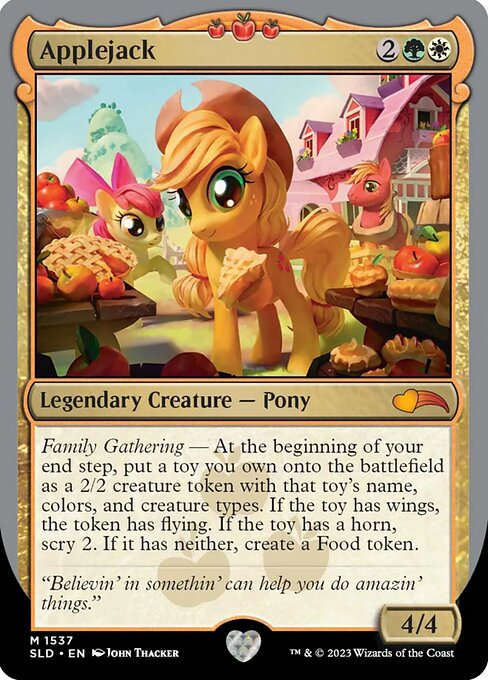
Image courtesy of Scryfall.com
Design lessons learned from Applejack's playtesting feedback
Playtesting is the crucible where theory meets the mana-splashed reality of a tabletop match. When you’re shaping a card as flavor-forward and mechanically rich as Applejack, you’re juggling a lot of moving parts: a two-color identity, a four-mana commitment, and the promise of a transformative end step. The feedback loop—from casual folks to power players—helps separate what tests well on a spreadsheet from what sings on a kitchen-table battlefield. 🧙♂️🔥 In Applejack, you can feel the tension between a strongGW frame and a token-driven engine that can quickly bloom into complicated board states. The result is a design anecdote that matters to future sets, not just a one-off novelty card. ⚔️
Color identity and the joy of two colors
Applejack wears green and white with a proud, two-color identity, paying a mana cost of {2}{G}{W}. That pairing is not accidental: it channels both the resilience of green and the order of white, steering the design toward a creature that rewards sturdy board presence and thoughtful sequencing. Playtesters appreciated the clarity of the color requirements—this isn’t a card that tries to do everything at once; it leans into token generation as an extension of the battlefield narrative. The lesson here is simple for future design: align color identity with a compact, repeatable payoff. When players see green and white in the cost, they borrow a sense of growth and structure, which Applejack amplifies through its end-step token generation. 🎨
End steps, toys, and token economy
The core mechanic—“At the beginning of your end step, put a toy you own onto the battlefield as a 2/2 creature token with that toy's name, colors, and creature types”—is a clever design space opener. It breathes life into the idea of a card-sleeved narrative: your toys become creatures, sometimes with wings (flying) or horns (scry 2). If neither feature appears, you still get a Food token, which is the delightful fallback that keeps the engine robust but not overbearing. Playtesters highlighted two truths: first, the token interplay invites memorable moments, and second, the text must remain readable under the pressure of a busy board state. The precise templating—“as a 2/2 creature token with that toy's name, colors, and creature types”—is a masterclass in micro-design: it’s specific enough to be meaningful, flexible enough to support a spectrum of toys, and scalable across different play sessions. 🧩
“Keep the token text modular: a token should feel like a discrete payoff that can be toggled by different toy attributes, not a wall of words that requires a glossary to understand mid-game.”
That feedback translated into a broader principle: when you ship a mechanic that hinges on a player’s personal collection (toys you own), you must anticipate how ownership and deck-building habits influence timing and value. The end step is a quiet moment, but it can become the loudest turn if the tokens start stacking up. The cure is a clean trigger window paired with clear token outcomes, preventing confusion during the critical post-combat phase. The lesson for designers is to provide a dependable rhythm—trigger timing, a predictable token type, and a clear linkage to color-based outcomes (flying, scry, or Food). 🧭
Flavor, lore, and mechanical transparency
Applejack isn’t just a creature on a card; she’s a vehicle for a playful, family-centered mythos—hence the name “Family Gathering” as a keyword and the flavor text about belief powering amazing things. The Secret Lair Drop setting and the silver border frame evoke a special collection moment, nodding to fans who crave unique, collectible design experiences. Playtesters rewarded trials that balance flavorful storytelling with readable, actionable text. The design takeaway: if your card tells a story, ensure the mechanical payoff lands with the same confidence that flavor carries. A card’s theme should illuminate, not obscure, the impact of its abilities. And yes, the horn-wings-scry-food synergy gives a little wink to players who enjoy thematic callbacks and token economy flavor. 🥳
Balancing power with accessibility
Secret Lair drops often challenge the boundaries of power and accessibility. Applejack sits at a Mythic rarity tier, yet its ultimate value emerges not from raw punch but from the evolving board state it creates—end-step token generation that scales with the toys you own. The feedback from testers consistently pointed to two priorities: readability and resilience. The ability text should be straightforward enough for newer players to parse quickly, while still offering subtle depth for veterans who want to plan multiple turns ahead. The metric for success here is not only “does it work?” but “does it feel satisfying when it works?” The answer, from playtests, was a confident yes. 🔍
Design lessons at a glance
- Make color identity reflect in the payoff: GW here reinforces a synergy between growth and order, guiding players toward a stable play pattern.
- Clarify timing and outcomes: end-step triggers paired with modular token outcomes keep playsmooth and approachable.
- Embrace token economy thoughtfully: tokens should provide meaningful decisions without exploding complexity.
- Balance flavor with readability: a strong narrative can elevate a card, but the text must stay accessible under pressure.
- Celebrate collectible moments without gatekeeping: the Secret Lair veneer should feel special while remaining mechanically coherent in ordinary play.
As designers, we’re always testing ideas against the real world—how hands move, how quickly players parse text, and how a board state evolves as mortal beings with coffee cups in hand navigate the turn order. Applejack proves that a well-scoped mechanic anchored in two-color identity can spark excitement without overwhelming players. And in the broader MTG ecosystem, it’s a reminder that lore-friendly design can coexist with crisp, executable rules. 🧙♂️💎
If you’re curious to explore more real-world design stories, swing by these articles that fueled the conversation around creative mechanics and enduring MTG art:
Rugged Phone Case for iPhone & SamsungMore from our network
- https://blog.digital-vault.xyz/blog/post/why-players-love-un-set-chaos-finishing-blow-edition/
- https://crypto-acolytes.xyz/blog/post/minecraft-warden-explained-survive-detect-and-defeat/
- https://blog.digital-vault.xyz/blog/post/swats-iconic-mtg-art-what-makes-it-timeless/
- https://crypto-acolytes.xyz/blog/post/why-classic-mmorpgs-stay-alive-after-decades/
- https://blog.rusty-articles.xyz/blog/post/squee-the-immortal-time-spiral-goblin-origins/